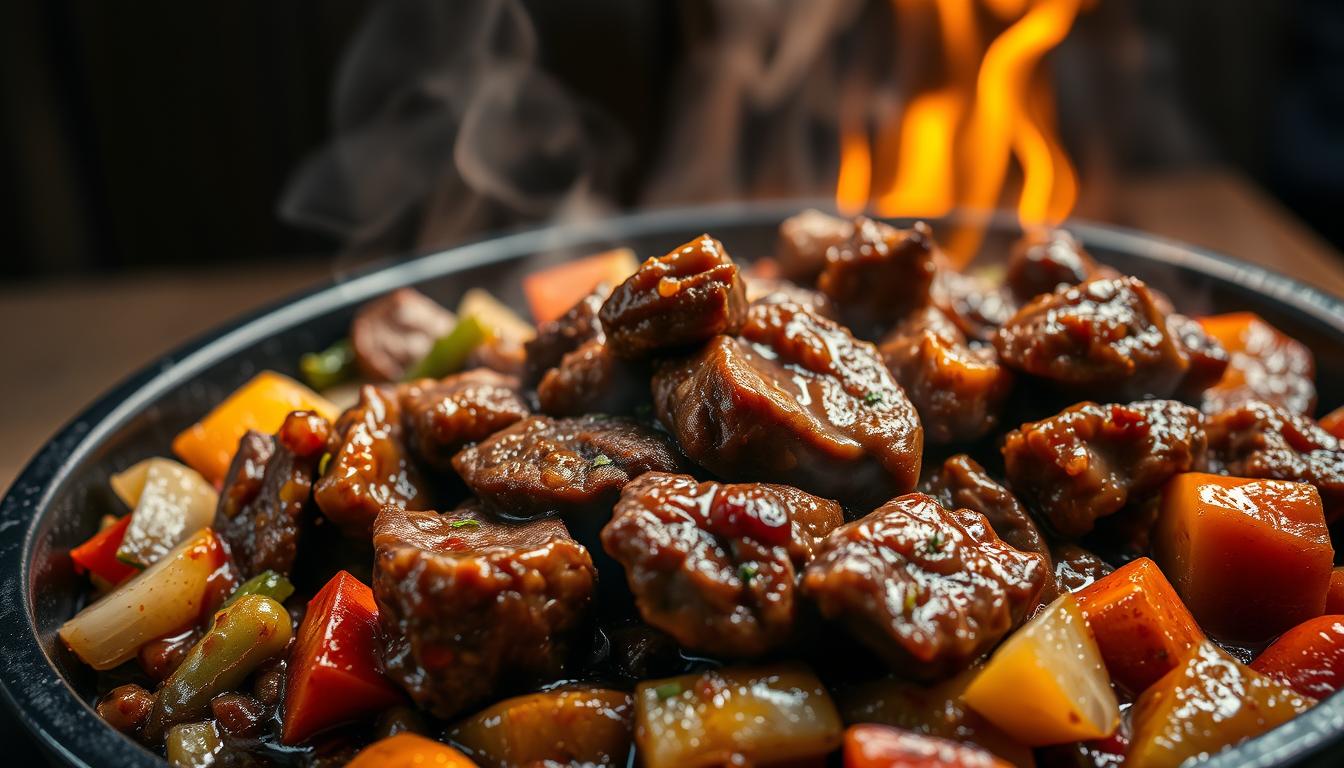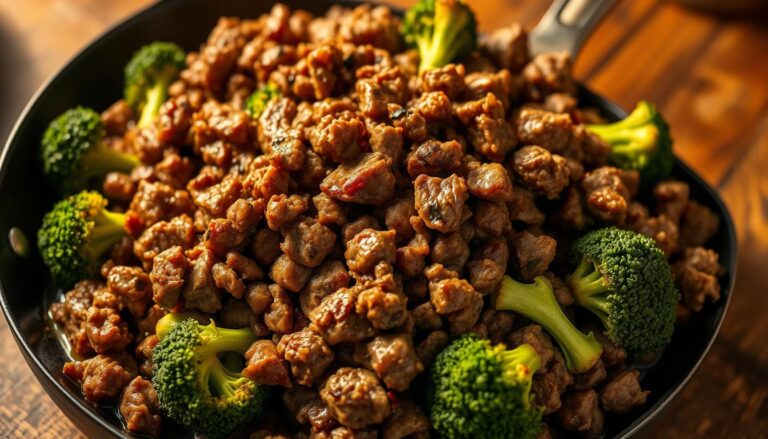Easy Korean Beef Bulgogi: Quick, Authentic Dinner Ideas
The smell of sizzling Korean beef bulgogi can turn a simple dinner into a special event. I remember watching my grandmother make this dish. It was a mix of sweet and savory that left lasting memories.
Korean beef bulgogi is more than a recipe; it’s a way to connect with family. This classic Korean BBQ beef dish is called “fire meat.” It shows the bold flavors and cooking style of Korean cuisine.
Whether you’re an experienced cook or just starting, learning to make beef bulgogi can improve your cooking. This dish is easy to make and can be enjoyed any time. It’s great for quick weeknight meals or weekend parties.
Table of Contents
Understanding Korean Beef Bulgogi: A Traditional Delight
Explore the world of bulgogi, a beef food recipe loved for centuries. It’s more than a meal; it’s a journey through time and tradition.
Korean bulgogi dates back to the Goguryeo era (37 BC–668 AD). It was first called “maekjeok,” meaning “meat grilled on a skewer”. Now known as “bulgogi,” it means “fire meat,” showing its unique cooking method.
Origins and Cultural Significance
The story of bulgogi is a tale of Korean culinary heritage. In the Joseon Dynasty (1392–1897), it evolved from simple skewered meat to the complex dish we know today.
- Originated in ancient Korean kingdoms
- Evolved from skewered meat to marinated delicacy
- Represents cultural cooking traditions
What Makes Bulgogi Special
Bulgogi’s flavor is unique. It combines sweet, savory, and umami for a memorable taste. Made with special beef cuts, it highlights Korean cooking’s artistry.
“Bulgogi is not just a meal, it’s a celebration of flavor and tradition.” – Korean Culinary Expert
Traditional vs Modern Preparation
Traditionally, bulgogi was cooked over open flames. Now, modern recipes make it easy to prepare at home. You can cook it on the stovetop or grill.
- Traditional: Skewer-based cooking
- Modern: Versatile preparation methods
- Consistent focus on flavor and technique
Essential Ingredients for Authentic Bulgogi
Making perfect bulgogi beef needs the right ingredients and knowing the flavors that make it special. Whether you love jo cooks or are new to Korean cooking, picking the right ingredients is key. This ensures your meal tastes authentic.
Choosing the right beef is your first step to success. The top picks are:
- Boneless ribeye – The premium choice with exceptional marbling
- Top sirloin – A leaner alternative with great flavor
- Beef tenderloin – Extremely tender and succulent
Best Cuts of Beef to Use
Experts say use 1½ pounds of boneless ribeye for a true bulgogi beef recipe. Slice the meat very thin. Freezing it for 15-30 minutes helps.
Key Marinade Components
A traditional bulgogi marinade mixes sweet and savory. You’ll need:
- ½ cup soy sauce
- 3 tablespoons brown sugar
- 1 Asian pear (approximately 6 ounces)
- 1 teaspoon minced ginger
- ¼ teaspoon cracked black pepper
Optional Add-ins and Variations
Bulgogi lets you get creative. Try adding sesame oil, rice wine, or fresh garlic to your marinade. This adds depth to your dish.
Pro tip: Marinate your beef for a minimum of 6 hours, with overnight marination delivering the most robust flavors.
Perfect Meat Preparation Techniques
Mastering meat preparation is key for a great Korean beef bulgogi recipe. The secret to top-notch bulgogi is in how you slice and prepare the meat. When using your favorite cut of beef, being precise is crucial.
To get the most tender and flavorful koreansk mad, follow these essential steps:
- Partial Freezing Trick: Freeze your beef for 20-30 minutes before slicing. This makes cutting thin, even slices much easier.
- Aim for ultra-thin cuts of about 1/8 inch (2-3mm) thick
- Always slice against the grain to ensure maximum tenderness
Choosing the right cut is vital when preparing Korean beef recipes. Top sirloin, ribeye, and skirt steak are best for bulgogi. The meat should be boneless and lean for the perfect texture and flavor.
Pro tip: A sharp knife is your best friend when slicing meat for bulgogi. Take your time and focus on creating uniform, thin slices. This way, the beef will cook quickly and evenly. Your patience will be rewarded with melt-in-your-mouth beef that captures the essence of traditional Korean cuisine.
Crafting the Ultimate Bulgogi Marinade
Making the perfect Korean beef marinade is an art. It turns simple meat into a culinary masterpiece. In Korean cooking, the marinade is more than seasoning. It’s the soul of easy bulgogi that adds depth and character to every bite.

The secret to a great bulgogi marinade is balancing sweet and savory flavors. Traditional Korean methods use unique ingredients. These ingredients tenderize and enhance the meat’s natural taste.
Fruit-Powered Tenderizing Techniques
Asian pear is the magic ingredient in Korean beef marinades. It serves two critical purposes:
- Natural meat tenderization
- Adding subtle sweetness
- Breaking down protein fibers
Marination Mastery
When making your easy bulgogi, follow these marination guidelines:
- Use ripe Asian pear or apple for optimal tenderizing
- Limit marination to 2-4 hours for best texture
- Avoid over-marinating, which can make meat mushy
Flavor-Enhancing Ingredients
A stellar bulgogi marinade includes:
- Soy sauce for umami depth
- Garlic for aromatic intensity
- Sesame oil for nutty undertones
- Brown sugar or honey for caramelization
By mastering these techniques, you’ll create a Korean beef marinade. It will bring restaurant-quality flavor right to your kitchen.
Cooking Methods and Best Practices
Learning to cook bulgogi is all about mastering different techniques. These methods help bring out the meat’s rich flavors. Whether you’re making rice lettuce wraps or a potato sandwich, the cooking method matters a lot.
You can cook bulgogi in two main ways: pan-frying and grilling. Each method has its own benefits that can make your soy sauce garlic marinade even better.
Pan-Frying Techniques
Pan-frying bulgogi releases juices that mix well with rice. Here are some tips:
- Use a hot skillet for quick cooking
- Cook thin slices in small batches
- Avoid overcrowding the pan
Grilling Methods
Grilling adds a charred flavor that many love. The high heat makes the meat’s surface caramelized, creating a tasty crust.
- Preheat grill to medium-high heat
- Cook 2-3 minutes per side
- Watch for perfect golden-brown edges
“The secret to perfect bulgogi is in the cooking technique, not just the marinade.” – Korean Culinary Expert
Pro tip: Always let the meat rest for 3-5 minutes after cooking. This helps keep it juicy.
Korean BBQ-Style Serving Suggestions
To make your homemade bbq beef taste like real Korean food, it’s not just about cooking. You need to think about how you present it. Choose the right sides to make your meal special.

Traditional Accompaniments
Here are some classic Korean ways to serve bulgogi:
- Fresh lettuce leaves for wrapping
- Steamed white rice
- Ssamjang (Korean dipping sauce)
- Kimchi as a side dish
Modern Plating Ideas
Make your dish look great with these modern ideas:
- Use shallow ceramic bowls with compartments
- Arrange meat slices in overlapping patterns
- Garnish with sesame seeds and green onions
- Add colorful banchan around the main dish
Rice and Banchan Pairings
Pair your resepi biskut and Korean beef with these perfect sides:
| Rice Type | Recommended Banchan |
|---|---|
| Steamed Jasmine Rice | Cucumber Kimchi |
| Brown Rice | Pickled Radish |
| Cauliflower Rice | Spicy Daikon |
“The secret to a great Korean BBQ is in the details of serving and sharing.”
Tips for Achieving Restaurant-Quality Results
Making authentic Korean beef bulgogi at home is easy. Just use a few expert tips to make your beef bulgogi recipe amazing.
For top-notch Korean BBQ beef, focus on a few cooking tricks:
- Use a well-seasoned cast iron skillet for maximum flavor
- Cook meat in small batches to prevent overcrowding
- Preheat your pan on high heat for perfect caramelization
- Slice beef extremely thin for quick, even cooking
Professional chefs say timing and heat control are key. When cooking your Korean beef bulgogi, timing and heat management are crucial. You want to sear the meat fast, keeping juices in and getting a nice caramelized look.
For the best results, follow these tips from Korean BBQ pros. Professional techniques can make your home-cooked meal taste like it’s from a restaurant. Remember, the more you cook bulgogi, the better you’ll get.
Pro tip: Let your meat rest for a few minutes after cooking to ensure maximum tenderness and flavor absorption.
Storage and Meal Prep Guidelines
Turning your beef recipes into meal prep is simple. The bulgogi recipe is perfect for meal prep. It lets you enjoy tasty BBQ dishes with little daily cooking.
Keeping your Korean beef bulgogi fresh is key. It’s a big help on busy weeknights.
Refrigeration Strategies
Here’s how to store your bulgogi right:
- Cooked bulgogi stays good in an airtight container for 3-4 days
- Uncooked, marinated bulgogi keeps for 3-4 days in the fridge
- Use clean, sealed containers to avoid contamination
Freezing Techniques
Freezing bulgogi is great for future meals:
- Freeze cooked or uncooked bulgogi for up to 3 months
- Freeze in individual portions for easy thawing
- Choose freezer-safe containers or vacuum-sealed bags
Reheating Tips
Pro tip: Reheat bulgogi gently to keep it juicy. Use a skillet on medium-low or microwave with a damp paper towel to avoid drying.
“The secret to great leftover bulgogi is gentle reheating and keeping the moisture intact.” – Korean Cooking Expert
Learn these storage and meal prep tips. You’ll always have a tasty beef dish ready to go.
Conclusion
Your journey into bulgogi beef has made home cooking special. You’ve learned from classic Korean recipes to make dishes as good as restaurants. Bulgogi’s secret is simple: thin beef, a strong marinade, and careful cooking to keep the meat tender.
Learning about bulgogi opens up a world of cooking. Whether you’re inspired by jo cooks or traditional methods, there’s always something new. Ground beef lovers can even make their own Korean-inspired dishes with authentic flavors.
Mastering bulgogi is about respecting tradition and adding your own twist. From choosing the right ribeye to balancing flavors, your skills will wow everyone. Mapo tofu might be popular, but bulgogi beef is a true favorite that brings people together through food.
Keep exploring Korean cuisine and enjoy the rich flavors behind each dish. Your kitchen is now a doorway to Korea’s vibrant tastes, one bulgogi recipe at a time.







